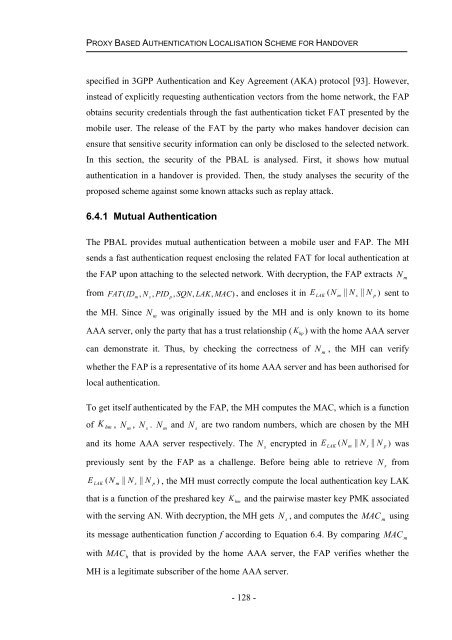Handover mechanisms in next generation heterogeneous wireless ...
Handover mechanisms in next generation heterogeneous wireless ...
Handover mechanisms in next generation heterogeneous wireless ...
You also want an ePaper? Increase the reach of your titles
YUMPU automatically turns print PDFs into web optimized ePapers that Google loves.
PROXY BASED AUTHENTICATION LOCALISATION SCHEME FOR HANDOVER<br />
specified <strong>in</strong> 3GPP Authentication and Key Agreement (AKA) protocol [93]. However,<br />
<strong>in</strong>stead of explicitly request<strong>in</strong>g authentication vectors from the home network, the FAP<br />
obta<strong>in</strong>s security credentials through the fast authentication ticket FAT presented by the<br />
mobile user. The release of the FAT by the party who makes handover decision can<br />
ensure that sensitive security <strong>in</strong>formation can only be disclosed to the selected network.<br />
In this section, the security of the PBAL is analysed. First, it shows how mutual<br />
authentication <strong>in</strong> a handover is provided. Then, the study analyses the security of the<br />
proposed scheme aga<strong>in</strong>st some known attacks such as replay attack.<br />
6.4.1 Mutual Authentication<br />
The PBAL provides mutual authentication between a mobile user and FAP. The MH<br />
sends a fast authentication request enclos<strong>in</strong>g the related FAT for local authentication at<br />
the FAP upon attach<strong>in</strong>g to the selected network. With decryption, the FAP extracts m N<br />
from FAT( IDm<br />
, N s , PID p , SQN,<br />
LAK,<br />
MAC)<br />
, and encloses it <strong>in</strong> E LAK ( N m || N s || N p ) sent to<br />
the MH. S<strong>in</strong>ce N m was orig<strong>in</strong>ally issued by the MH and is only known to its home<br />
AAA server, only the party that has a trust relationship ( K hp ) with the home AAA server<br />
can demonstrate it. Thus, by check<strong>in</strong>g the correctness of N m , the MH can verify<br />
whether the FAP is a representative of its home AAA server and has been authorised for<br />
local authentication.<br />
To get itself authenticated by the FAP, the MH computes the MAC, which is a function<br />
of K hm , m N , s N . m N and N s are two random numbers, which are chosen by the MH<br />
and its home AAA server respectively. The N s encrypted <strong>in</strong> ) || || ( E LAK N m N s N p was<br />
previously sent by the FAP as a challenge. Before be<strong>in</strong>g able to retrieve N s from<br />
E LAK ( N m || N s || N p ) , the MH must correctly compute the local authentication key LAK<br />
that is a function of the preshared key K hm and the pairwise master key PMK associated<br />
with the serv<strong>in</strong>g AN. With decryption, the MH gets s N , and computes the MAC m us<strong>in</strong>g<br />
its message authentication function f accord<strong>in</strong>g to Equation 6.4. By compar<strong>in</strong>g MAC m<br />
with MAC h that is provided by the home AAA server, the FAP verifies whether the<br />
MH is a legitimate subscriber of the home AAA server.<br />
- 128 -












